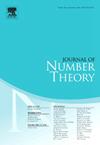斐波那契素数,形式为 2 - k 及以上的素数
IF 0.6
3区 数学
Q3 MATHEMATICS
引用次数: 0
摘要
我们推测指数增长的整数线性递推序列 (un)n≥0 中素数的分布。通过调整一个成功用于预测多项式素数的启发式,我们猜测,要么只有有限个素数 un,要么存在一个常数 cu>0(我们可以给出很好的近似值),从而有 ∼culogN 个素数 un,n≤N,如 N→∞。我们将我们的猜想与有限的数据进行比较。一个新特点是,我们的欧拉积中的素数不是按大小顺序排列的,而是按 un(modp) 周期的大小顺序排列的。本文章由计算机程序翻译,如有差异,请以英文原文为准。
Fibonacci primes, primes of the form 2n − k and beyond
We speculate on the distribution of primes in exponentially growing, linear recurrence sequences in the integers. By tweaking a heuristic which is successfully used to predict the number of prime values of polynomials, we guess that either there are only finitely many primes , or else there exists a constant (which we can give good approximations to) such that there are primes with , as . We compare our conjecture to the limited amount of data that we can compile. One new feature is that the primes in our Euler product are not taken in order of their size, but rather in order of the size of the period of the .
求助全文
通过发布文献求助,成功后即可免费获取论文全文。
去求助
来源期刊

Journal of Number Theory
数学-数学
CiteScore
1.30
自引率
14.30%
发文量
122
审稿时长
16 weeks
期刊介绍:
The Journal of Number Theory (JNT) features selected research articles that represent the broad spectrum of interest in contemporary number theory and allied areas. A valuable resource for mathematicians, the journal provides an international forum for the publication of original research in this field.
The Journal of Number Theory is encouraging submissions of quality, long articles where most or all of the technical details are included. The journal now considers and welcomes also papers in Computational Number Theory.
Starting in May 2019, JNT will have a new format with 3 sections:
JNT Prime targets (possibly very long with complete proofs) high impact papers. Articles published in this section will be granted 1 year promotional open access.
JNT General Section is for shorter papers. We particularly encourage submission from junior researchers. Every attempt will be made to expedite the review process for such submissions.
Computational JNT . This section aims to provide a forum to disseminate contributions which make significant use of computer calculations to derive novel number theoretic results. There will be an online repository where supplementary codes and data can be stored.
 求助内容:
求助内容: 应助结果提醒方式:
应助结果提醒方式:


